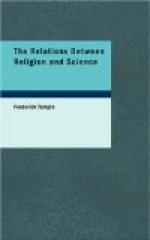with each successive generation. Now, the former
of these may be said to be well established, and we
recognise it as a law of life that all plants and
animals propagate their own kind. But the latter
has, as yet, been hardly examined at all. Each
new generation shows special slight variations.
But what causes these variations? and what determines
what they shall be? In Darwin’s investigations
these questions are not touched. The variations
are treated as if they were quite indefinite in number
and in nature. He concerns himself only with
the effect of these variations after they have appeared.
Some have the effect of giving the plant or animal
an advantage in the struggle of life; some give no
such advantage; some are hurtful. And hence follows
the permanent preservation or speedy destruction of
the plants and animals themselves. But we are
bound to look not only to their effects but to their
causes, if the theory is to be completed. And
then we cannot fail to see that these variations in
the progeny cannot be due to something in the progenitors,
or otherwise the variations would be all alike, which
they certainly are not. They must, therefore,
be due to external circumstances. These slight
variations are produced by the action of the surroundings,
by the food, by the temperature, by the various accidents
of life in the progenitors. Now, when we see
this, we see also how gravely it modifies the conclusions
which we have to draw concerning the ancestry of any
species now existing. Let us take, for instance,
the great order of vertebrate animals. At first
sight the Darwinian theory seems to indicate that all
these animals are descended from one pair or one individual,
and that their unity of construction is due to that
fact; but if we go back in thought to the time at
which the special peculiarities were introduced which
really constituted the order and separated it from
other animals, we see that it is by no means clear
that it originated with one pair or with one individual,
and that, on the contrary, the probabilities are the
other way. Although the separation of this order
from the rest must have taken place very early, it
cannot well have taken place until millions of animals
had already come into existence. The prodigality
of nature in multiplying animal life is fully acknowledged
by Darwin, and that prodigality is apparently greatest
in the lowest and most formless type of animal.
There being, then, these many millions of living creatures
in existence, the external surroundings introduce into
them many variations, and among these the special
variations to which the vertebrate type is due.
It is quite clear that wherever the external surroundings
were the same or nearly the same, the variations introduced
would be the same or nearly the same. Now, it
is far more probable that external surroundings should
be the same or nearly the same in many places than
that each spot should be absolutely unlike every other
spot in these particulars. The beginnings of




